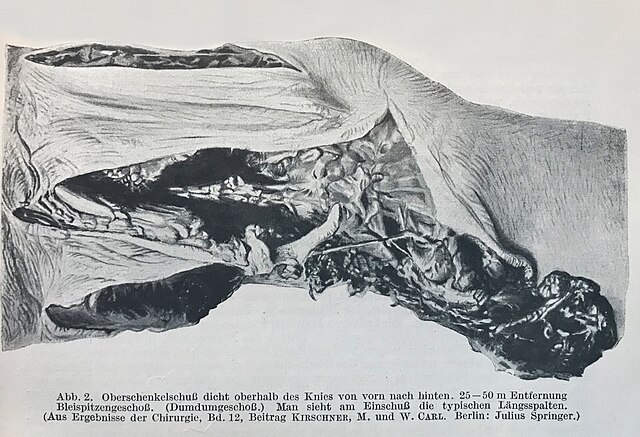A soft-point bullet (SP), also known as a soft-nosed bullet, is a jacketed expanding bullet with a soft metal core enclosed by a stronger metal jacket left open at the forward tip. A soft-point bullet is intended to expand upon striking flesh to cause a wound diameter greater than the bullet diameter. Jacketed soft point bullets are usually abbreviated JSP in the ammunition and reloading industry. The use of soft-point bullets in warfare is a violation of the Hague Convention of 1899, declaration IV, 3.
Some soft point bullets have a more aerodynamic contour like these spitzer boat-tail bullets
.357 Magnum rounds. Left: Jacketed flat/soft point (JFP/JSP). Right: Jacketed hollow point (JHP). JSP is a semi-jacketed round as the jacket does not extend to the tip. The notches on the tip of the JHP assist in the expansion of the bullet on impact with soft tissue.
Expanding bullets, also known colloquially as dumdum bullets, are projectiles designed to expand on impact. This causes the bullet to increase in diameter, to combat over-penetration and produce a larger wound, thus dealing more damage to a living target. For this reason, they are used for hunting and by most police departments, but are generally prohibited for use in war. Two typical designs are the hollow-point bullet and the soft-point bullet.
Leg wound by a dumdum bullet
Composite image of the British Medical Journal article describing Capt Bertie-Clay's new type of bullet (British Medical Journal 1896;2:1810)
German WWI propaganda: French Dum-Dum bullets (c. 1916)
Expanded .458 hunting round (next to a Ugandan 500-shilling coin [23.5 mm diameter] for size reference), after killing an African buffalo






![Expanded .458 hunting round (next to a Ugandan 500-shilling coin [23.5 mm diameter] for size reference), after killing an African buffalo](https://upload.wikimedia.org/wikipedia/commons/thumb/a/ad/Expanding_bullet_after_firing.jpg/640px-Expanding_bullet_after_firing.jpg)